Wyoming is the least populated state in America, even though it’s the 10th largest state in surface space. There is only an average of 5.85 people per square mile. Wyoming is famous for its Yellowstone National Park, a total of 2.2 million acres of natural beauty, rugged wilderness, and abundant wildlife. Its iconic spots are Old Faithful, Lower Falls, and Yellowstone Lake, which are often seen in landscape paintings.
Wildlife in Wyoming includes 400 species of birds and more than a hundred species of mammals. Bison is the state animal of Wyoming, but it also has other mammals such as mountain lions, deer, grizzly bears, and moose. Unfortunately, some animals are already extinct.
Here are ten extinct animals that once roamed the state of Wyoming:
1. Diplodocus
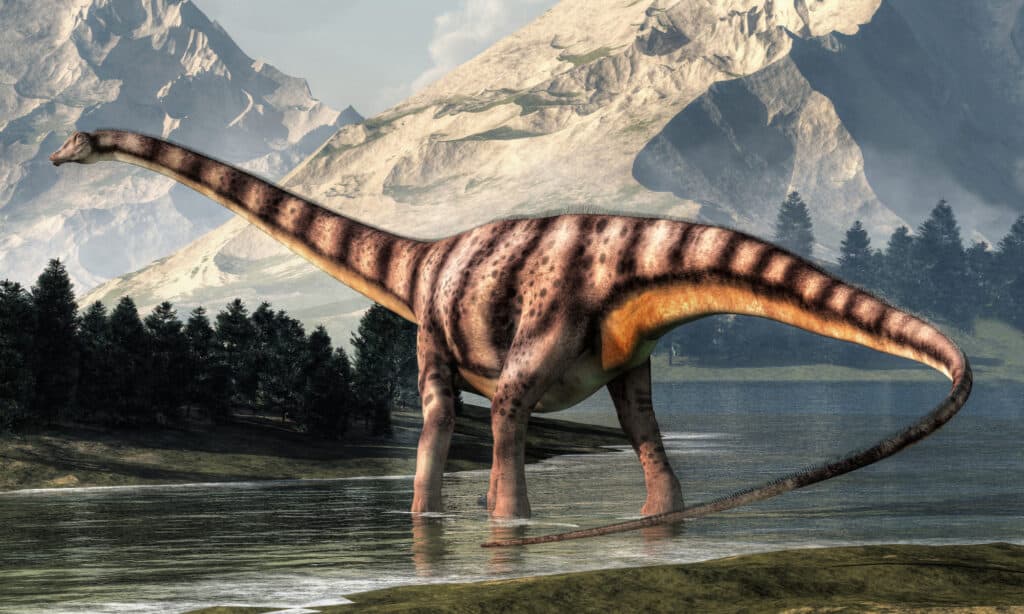
Diplodocus were herbivorous dinosaurs that ate leaves and ferns.
©Daniel Eskridge/Shutterstock.com
| Diplodocus | |
|---|---|
| Kingdom | Animalia |
| Phylum | Chordata |
| Clade | Dinosauria |
| Clade | Saurischia |
| Clade | Sauropodomorpha |
| Clade | Sauropoda |
| Family | Diplodocidae |
| Genus | Diplodocus |
| Species | Diplodocus longus |
| Extinct since | 66 million years ago |
Diplodocus, also known as Diplodocus longus, were herbivorous dinosaurs that ate leaves and ferns. Most of the time, they belong to a herd. Their long necks were their most iconic feature, and they have 15 vertebrae.
The first skeleton of Diplodocus was discovered in 1877 at Dinosaur Ridge in Morrison, Colorado. However, Wyoming is where a complete Diplodocus fossil was unearthed in 1899.
2. Camarasaurus

The Camarasaurus is part of the sauropod family.
©Catmando/Shutterstock.com
| Camarasaurus | |
|---|---|
| Kingdom | Animalia |
| Phylum | Chordata |
| Clade | Dinosauria |
| Clade | Saurischia |
| Clade | Sauropodomorpha |
| Clade | Sauropoda |
| Clade | Macronaria |
| Family | Camarasauridae |
| Genus | Camarasaurus |
| Species | Camarasaurus supremus |
| Extinction since | 66 million years ago |
The Camarasaurus is part of the sauropod family. Sauropods were the largest dinosaurs during the Jurassic period, and their long necks were their most distinguishing feature. The Camarasaurus and the other Sauropods were herbivores who walked on four thick legs.
The first specimen of Camarasaurus was found in Montana, representing the northmost occurrence of a sauropod in the Morrison Formation. Further studies about the species of Camarasaurus were conducted by the Wyoming Dinosaur Center in 2005.
3. Barosaurus
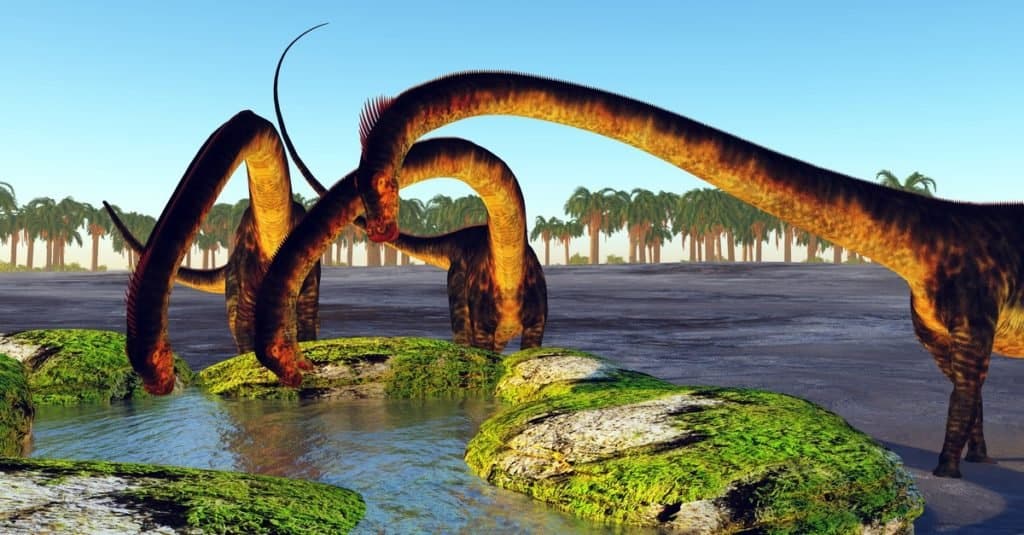
Barosaurus lentus is another species from the Sauropoda family.
©Catmando/Shutterstock.com
| Barosaurus | |
|---|---|
| Kingdom | Animalia |
| Phylum | Chordata |
| Clade | Dinosauria |
| Clade | Saurischia |
| Clade | Sauropodomorpha |
| Clade | Sauropoda |
| Family | Diplodocidae |
| Genus | Barosaurus |
| Species | Barosaurus lentus |
| Extinct since | 66 million years ago |
Barosaurus lentus is another species from the Sauropoda family that roamed the Earth during the Jurassic Period. They have long necks and tails, and they feed on plants.
4. Apatosaurus
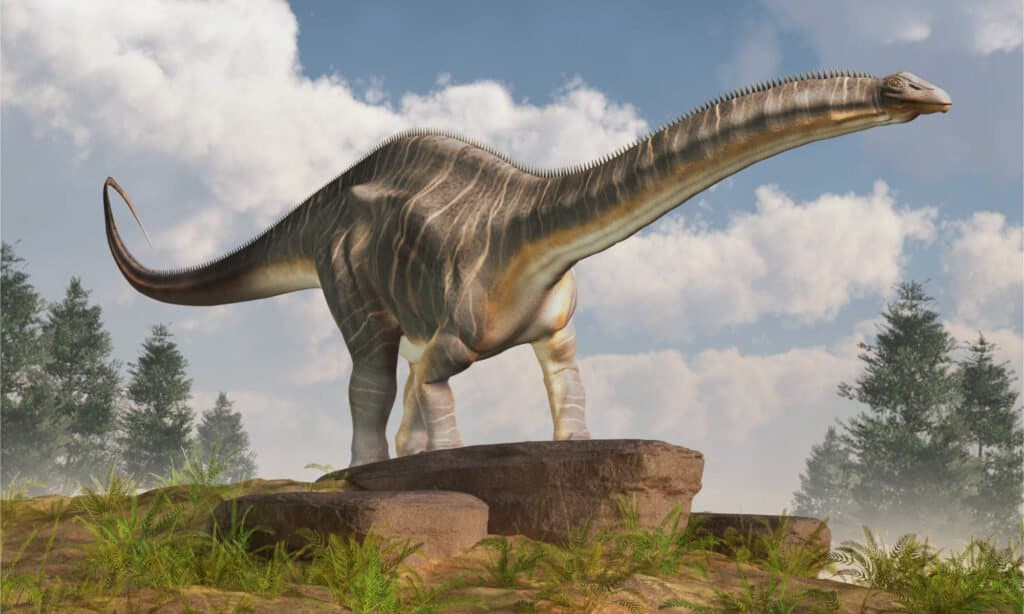
Apatosaurus was a four-legged herbivorous dinosaur that belonged to the Sauropoda family.
©Daniel Eskridge/Shutterstock.com
| Apatosaurus | |
|---|---|
| Kingdom | Animalia |
| Phylum | Chordata |
| Clade | Dinosauria |
| Clade | Saurischia |
| Clade | Sauropodomorpha |
| Clade | Sauropoda |
| Family | Diplodocidae |
| Genus | Apatosaurus |
| Species | Apatosaurus ajax Apatosaurus louisae |
| Extinct since | 66 million years ago |
Apatosaurus was a four-legged herbivorous dinosaur that belonged to the Sauropoda family. Apatosaurus also has Saurupoda’s iconic long necks and tails. However, there are several differences when compared to other dinosaurs.
5. Tyrannosaurus rex
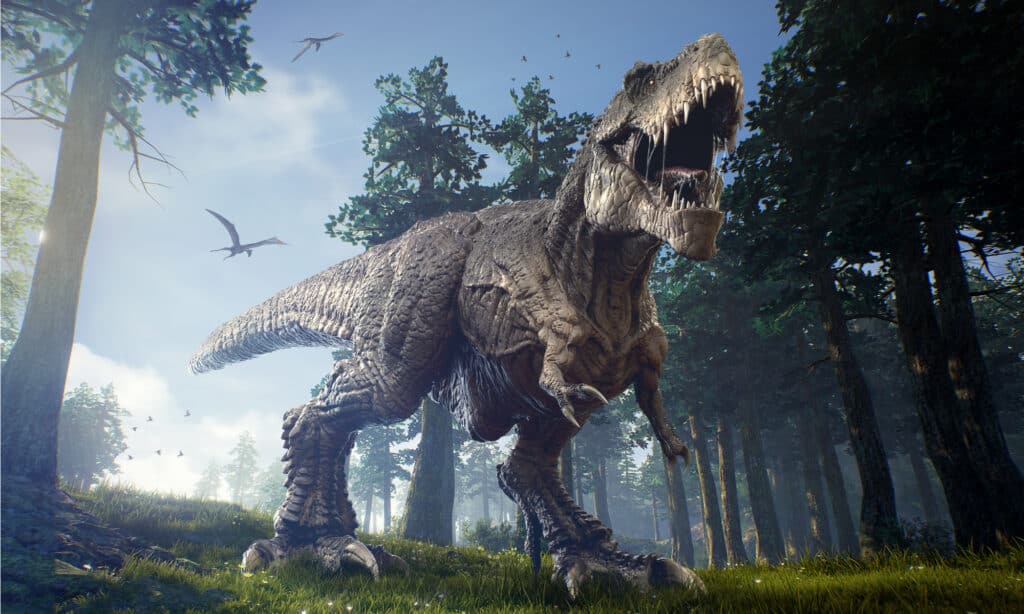
Tyrannosaurus Rex is a carnivorous dinosaur from the sub-order Theropoda that lived from the Jurassic Period.
©Herschel Hoffmeyer/Shutterstock.com
| Tyrannosaurus rex | |
|---|---|
| Kingdom | Animalia |
| Phylum | Chordata |
| Class | Reptilia |
| Order | Saurischia |
| Sub-Order | Theropoda |
| Family | Tyrannosauridae |
| Genus | Tyrannosaurus |
| Species | Tyrannosaurus Rex (other species in latest studies are Tyrannosaurus Bataar, Tyrannosaurus Imperator, and Tyrannosaurus Regina) |
| Extinct since | 66 million years ago |
The T. Rex, scientifically named Tyrannosaurus Rex, is a carnivorous dinosaur from the sub-order Theropoda that lived from the Jurassic Period to the end of the Late Cretaceous. Because they were the most ferocious predators that roamed the Earth, T. rex is often referred to as the King of the Tyrant Lizards. Some studies believed they were cannibals. Tooth traces on a young Tyrannosaurus are strong evidence that an adult Tyrannosaurus was feeding on the young. Their life expectancy is only up to 28 years, but they can weigh up to 18,000 pounds (9 tons) and be as tall as 12 to 13 feet off the ground.
The first and most complete skeleton specimens of Tyrannosaurus Rex were found in Montana. Then “Sue” was discovered in North Dakota. This new finding lured many scientists to look for more. According to studies, the specimens of Tyrannosaurus in Wyoming were found in the Hell Creek Formation, which stretches over portions of Montana, North Dakota, South Dakota, and Wyoming during the Upper Cretaceous.
6. Triceratops

Triceratops is a three-horned plant-eating dinosaur.
©freestyle images/Shutterstock.com
| Triceratops | |
|---|---|
| Kingdom | Animalia |
| Phylum | Chordata |
| Class | Reptilia |
| Order | Ornithischia |
| Sub-Order | Ceratopsia |
| Family | Ceratopsidae |
| Genus | Triceratops |
| Species | Triceratops horridus, Triceratops prorsus |
| Extinct since | 66 million years ago |
Triceratops are three-horned plant-eating dinosaurs. They are quadrupedal, which means they walk on four limbs. Triceratops are shorter when compared to Tyrannosaurus, but they are much heavier. According to research, Triceratops can weigh between 12,000 and 20,000 lbs.
Triceratops is the official state dinosaur of Wyoming. Peter Larson dug the most complete skeleton of Triceratops, discovered in Wyoming.
7. Woolly Mammoth

Woolly mammoths were scientifically named
Mammuthus primigenius.
©iStock.com/Aunt_Spray
| Woolly Mammoth | |
|---|---|
| Kingdom | Animalia |
| Phylum | Chordata |
| Class | Mammalia |
| Order | Proboscidea |
| Family | Elephantidae |
| Genus | Mammuthus |
| Species | Mammuthus Primigenius |
| Extinct since | Early Holocene – 11,000 years ago |
Woolly mammoths, scientifically named Mammuthus primigenius, are among the largest mammals that roamed North America during the Ice Age.
8. Columbian Mammoth
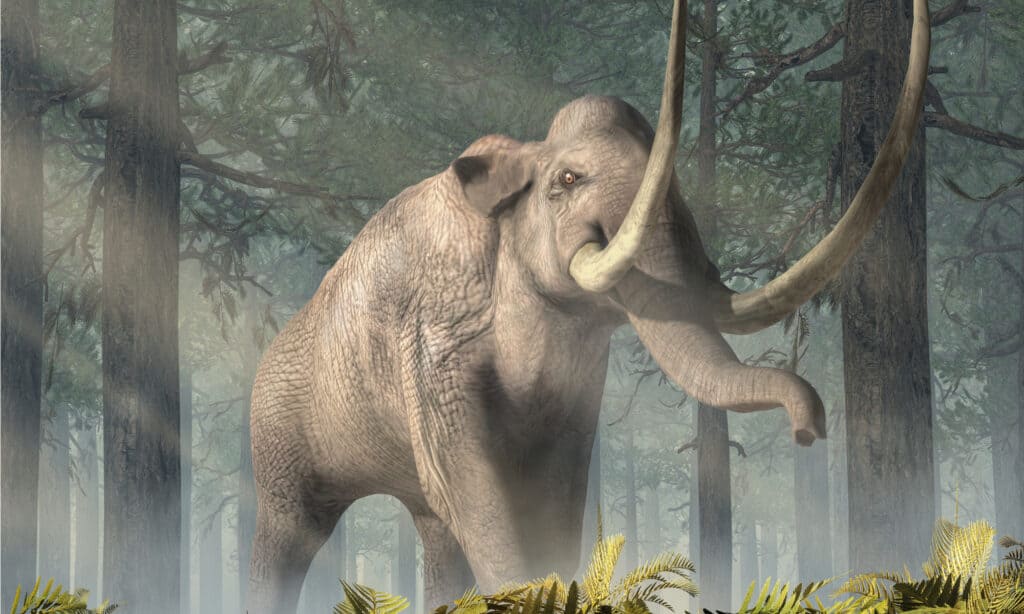
Columbian mammoths are hybrid species of woolly mammoths.
©Daniel Eskridge/Shutterstock.com
| Columbian Mammoth | |
|---|---|
| Kingdom | Animalia |
| Phylum | Chordata |
| Class | Mammalia |
| Order | Proboscidea |
| Family | Elephantidae |
| Genus | Mammuthus |
| Species | Mammuthus columbi |
| Extinct since | Early Holocene – 11,000 years ago |
Columbian mammoths, scientifically named Mammuthus columbi, are hybrid species of woolly mammoths. However, they have less visible fur compared to woolly mammoths. Some DNA studies suggest interbreeding between mammoths. In one of his studies, Olsen best described the distinction between a Woolly mammoth and a Columbian mammoth.
9. American Cheetah

The American
cheetah
is an extinct carnivorous species of mammal from the Felidae family.
©Sheatherius / CC BY-SA 4.0 – License
| American Cheetah | |
|---|---|
| Kingdom | Animalia |
| Phylum | Chordata |
| Class | Mammalia |
| Order | Carnivora |
| Sub-order | Feliformia |
| Family | Felidae |
| Subfamily | Felinae |
| Genus | Miracinonyx |
| Species | Miracinonyx inexpectatus |
| Living Period | Pliocene to Pleistocene |
The American cheetah, scientifically named Miracinonyx inexpectatus, is an extinct carnivorous species of mammal from the Felidae family. American cheetahs roamed West Virginia up to the Pleistocene Period.
10. Giant Short-faced Bear
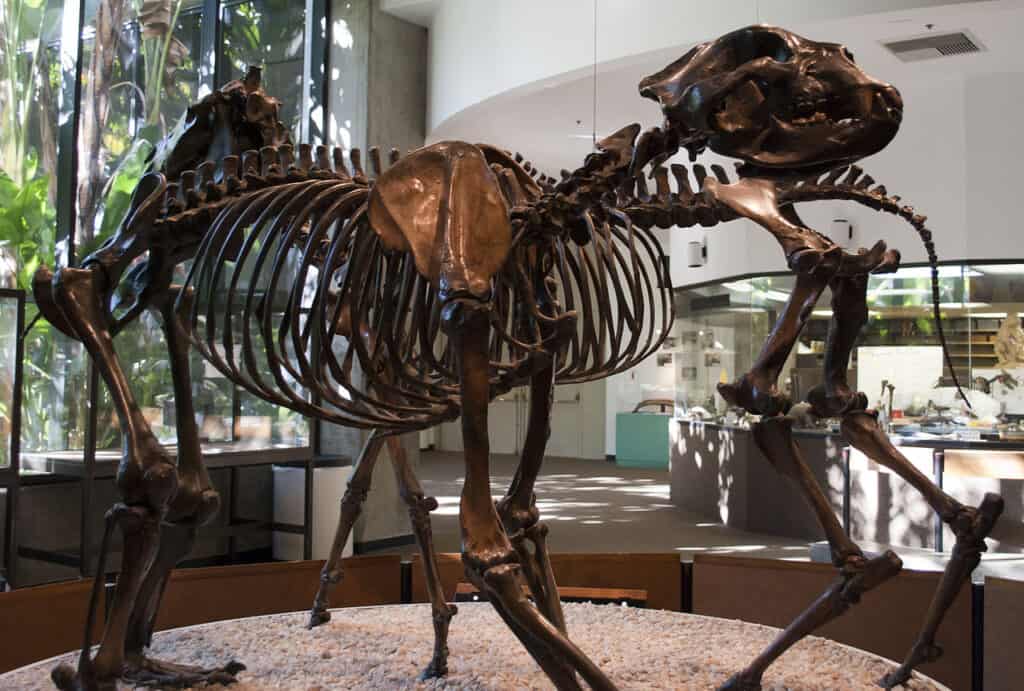
Arctodus simus belonged to the family of bears.
©Riku64 / CC BY-SA 3.0 – License
| Giant Short-faced Bear | |
|---|---|
| Kingdom | Animalia |
| Phylum | Chordata |
| Class | Mammalia |
| Order | Carnivora |
| Family | Ursidae |
| Genus | Arctodus |
| Species | Arctodus simus |
| Extinct since | 12,000 years ago |
The Arctodus simus, also known as the giant short-faced bear, was the largest mammalian carnivore during the Ice Age. Arctodus simus belonged to the family of bears, but they had longer limbs and shorter snouts, hence the name.
The photo featured at the top of this post is © Daniel Eskridge/Shutterstock.com
Thank you for reading! Have some feedback for us? Contact the AZ Animals editorial team.






